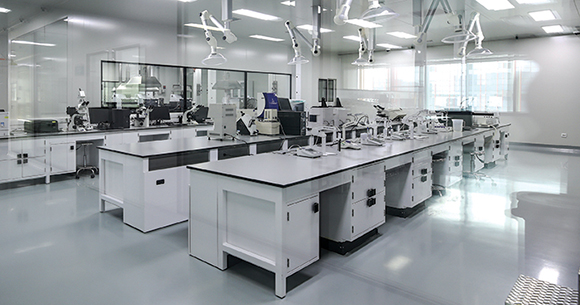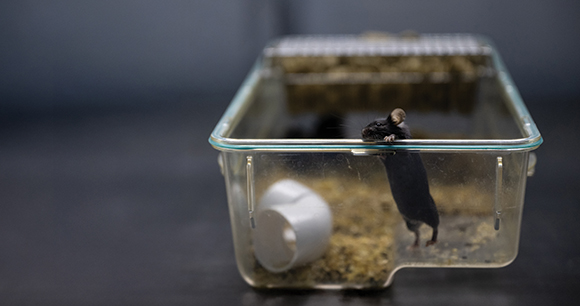Two agencies within the US Department of Health and Human Services have announced plans to move away from the use of animals in research and testing and transition toward nonanimal models. These announcements, however, came in the midst of a widespread effort by the Trump administration to drastically reduce the federal workforce and cut funding for scientific research—moves that will make the transition to nonanimal models much harder to achieve. In this article, AWI examines the ramifications of these actions for animals in laboratories.

The good: Plans to reduce animal experimentation
On April 10, the US Food and Drug Administration announced it would phase out animal testing for certain drug studies. The agency published a roadmap that outlines a six-prong approach to reducing toxicity testing in animals over the next three years and six scientific and technical steps for the agency to adopt nonanimal research models. Later that month, the National Institutes of Health announced its own initiative to “prioritize human-based research technologies” and “reduce [the] use of animals in NIH-funded research.” It intends to establish an Office of Research Innovation, Validation, and Application to coordinate these efforts and expand infrastructure for nonanimal research approaches.
The latter announcement was otherwise short on details, but most NIH-funded studies involve “basic” research—exploratory studies meant to advance general scientific knowledge, such as understanding the progression of disease. Nonanimal methodologies, unfortunately, are still in the early phases of development for this type of research. The FDA, by contrast, conducts animal testing to gauge the safety of drugs and other products for human use. In this realm, nonanimal methodologies are much more advanced.
The bad: Mass layoffs at federal agencies
Such plans would be very welcome news if not for the fact that the Trump administration is also in the process of gutting the very agencies responsible for such transitions. It has purged nearly 20 percent of the FDA workforce—including top officials in charge of reviewing new drugs—and an estimated one-eighth of the NIH staff have been fired or pushed out. The situation is beyond grim, according to a longtime NIH researcher quoted in Science: “However bad everyone on the outside thinks it is, it is a million times worse. They’re dismantling and destroying everything.”
Nine editors-in-chief of European toxicology journals coauthored an article in the journal Regulatory Toxicology and Pharmacology (Van den Berg et al., 2025) expressing alarm over the workforce reductions at US scientific agencies. Several of these editors’ journals are specifically dedicated to advancing research on nonanimal methodologies for toxicity testing—efforts they emphasize could be impeded by the loss of senior staff at US agencies. In fact, they say, the layoffs “pose a threat to the very foundation of regulatory science and the safeguarding of public welfare and environmental health and thus will impact negatively on the safety of food, water, air and medicines for every American.”
Mass staff reductions are occurring at the US Department of Agriculture as well. The department has a long history of failing to adequately enforce Animal Welfare Act compliance by laboratories, breeders, and other entities—due in part to insufficient staff. Continued layoffs and emphasis on deregulation will only exacerbate this issue, further diminishing protections for animals in research.
The ugly: Slashing scientific research funding
The Trump administration is also determined to drastically cut research funding by capping, canceling, or delaying funds provided by national funding agencies. At the time of writing, approximately 3,000 already-approved NIH and National Science Foundation grants have been terminated. Meanwhile, new NIH grant applications are processing at half the historical rate, and the NSF stopped awarding new grants altogether. Further, the agencies announced they would be capping “indirect costs” at 15 percent, although so far this effort has been blocked by courts. These largely administrative and facility costs added to grants go toward “keeping the lights on.” At many institutions, some percentage of these go toward animal welfare-related expenses, such as enrichment programs, facility upgrades, ethical review of study protocols, semiannual inspections, and animal care staff salaries. Over the past decade, the indirect cost rate has averaged nearly 28 percent, though at some institutions, the rate is much higher. Many researchers say that a reduction to 15 percent would debilitate research institutions and potentially result in mass euthanasia of animals.

In addition, the administration announced that dozens of universities are currently “under investigation,” and it has already frozen or canceled billions of dollars in federal funding to several of those universities for failing to comply with the administration’s demands, which vary from institution to institution. Research at Harvard’s Wyss Institute, responsible for pioneering organ-on-a-chip technology that can replace animals in tests and experiments, is one casualty of the funding freeze.
Thus far, $9.5 billion in research grants have been terminated, and further cuts are planned. The administration’s 2026 budget proposal seeks to cut scientific funding across the board, including reducing NSF and NIH budgets by approximately 55 and 40 percent, respectively. A recent Institute for Macroeconomic and Policy Analysis report concluded that even a 25 percent cut to public research spending would reduce the GDP by 3.8 percent—comparable to the decline during the Great Recession.
The fallout
The Trump administration’s actions suggest it is working at cross-purposes: It proclaims a mission to advance science through nonanimal methods while simultaneously slashing funding for research—including for nonanimal methods. If it also seeks to reduce animal suffering, decimating resources for their protection and care runs directly counter to that goal.
AWI strongly supports a transition away from the use of animals in experimentation, but this must be done in a manner that does not leave animals and people in the dust. Broad cuts to research without allocating funding for rehoming eligible animals will, in the short term, result in severely compromised welfare and mass euthanasia of animals currently housed in laboratories. In the long run, research using animals will be reduced, but not because nonanimal methods will have dramatically advanced in that time. Instead, it will largely be due to a reduction in research as a whole—including studies focused on public health, medicine, and species and ecosystem conservation, affecting an untold number of people and animals. As a science-based organization committed to advancing the welfare of all animals, AWI urges more thoughtful solutions.